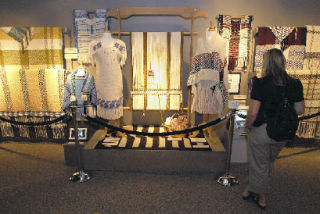When people think of the art forms of the native peoples of the Northwest Coast, painted totem poles and masks immediately spring to mind.
But that, said Patricia Cosgrove, director of the White River Valley Museum, leaves out a huge chunk of the story. For the southern people, the Salish people, wool weaving and basket weaving have been the dominant art form for thousands of years.
“Where carving tended to be a man’s art, weaving was a women’s art. The woven item was more personal, worn in a private setting, while carved and painted items were more of a public display of wealth and power. We as a community aren’t as sophisticated in our views of Salish as of Northern Coastal art,” Cosgrove said.
Good enough reason for the White River Valley Museum to celebrate the traditions of the Northwest Coast Salish people with a series of events and the exhibit “SQ3Tsya’yay: Weaver’s Spirit Power” through Nov. 9, courtesy of guest curator and master weaver Susan (sa’hLa mitSa) Pavel.
The exhibit features historical and contemporary Coast Salish fiber weavings, among them antique mountain goat wool blankets and modern weavings made of domestic sheep’s wool.
“Weaver’s Spirit Power” takes a close look at the Southern Coastal region, specifically southwestern Washington up to the southern tip of Vancouver Island, British Columbia, where the woven arts predominate.
For more than 40 years, the state had only three master Coast Salish fiber weavers: The late Bruce Miller from the Skokomish Nation, and Fran and Bill James from the Lummi Nation. These masters occasionally took on an apprentice, and the number of active Coast Salish weavers remained limited.
In 1996 Pavel, of Filipino heritage, was dating Michael Pavel, a Skokomish man – she later married him – and working on her Ph.D. in education. Academically brilliant, Pavel had a shortcoming in the eyes of tribal members – she couldn’t cook.
“If I was going to be married to an Indian man, what good is a woman if she can’t cook? So they said ‘let us teach her some usable trade like weaving.’ I think my husband and Bruce Miller were in cahoots in this,” Pavel said.
Miller, known as “Uncle,” took the young woman on as an apprentice in the summer of 1996.
“I cleaned the wool, picked the wool, carted the wool, spun the wool, dyed the wool, warped it and finally wove it,” Pavel said. “The only thing I didn’t do was shear the sheep.”
For each of the next three summers as Pavel learned her craft, she turned out one blanket, which she gave to her teacher, her mother in law and her husband.
Pavel apprenticed with Miller for six years and became a master weaver and teacher in her own right. Since 2002, she has been demonstrating and presenting weaving of the Coast Salish peoples with a passion, and commitment that have inspired Native and non-Native people.
To date, more than 500 people have taken weaving classes from her.
“I think in the big picture why weaving matters is that weaving is used as a synonym for lots of things,” said Pavel. “We’re stronger woven together than we are singly.
“If you look at a single fiber on any weaving, it can amount to nothing until it’s woven and strung with a neighbor and another neighbor and another. I think this sits in the mind of every culture, whether people realize it or not. And every culture has a weave style, has taken the natural fibers in their region and made something from it. And the Coastal Salish are no exception.”
Robert Whale can be reached
at 253-833-0218, ext. 5052,
or rwhale@reporternewspapers.com
Weaving lineup
Unless otherwise noted, events are free with regular museum admission of $2 adults, $1 children and seniors.
• Sept. 20: weaving demonstrations, noon-4 p.m. Local weavers demonstrate both the twill and twine techniques of Coast Salish weaving.
• Oct. 11: film, lecture with Susan Pavel, 1-3 p.m. A 20-minute film highlights the weaving process from gathering plant material to weaving, followed by a lecture that covers the historical significance, revitalization efforts and future of Coast Salish Weaving. Questions from the audience encouraged.
• Nov. 1: Salish weaving family day, noon-4 p.m. A hands-on adventure for the entire family. Identify raw weaving materials, weave on a Coast Salish loom, create a greeting card for friends and family, and pose for the camera in an authentic Coast Salish woven blanket.
The White River Valley Museum, located at 918 H St. S.E. in Auburn, is open Wednesday through Sunday. Regular hours are noon-4 p.m. Admission is free on Wednesdays. Call 253-288-7433 or visit www.wrvmuseum.org for information.



